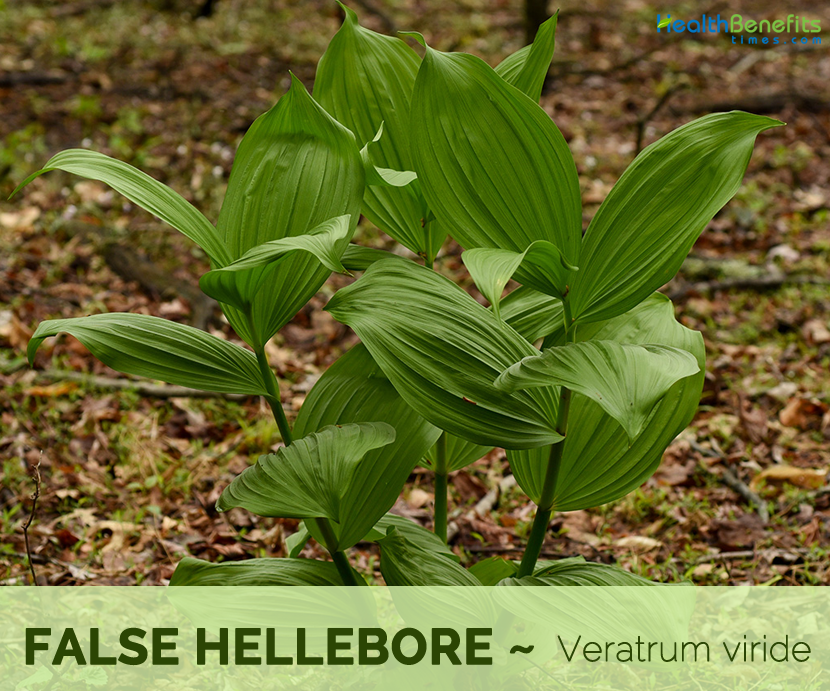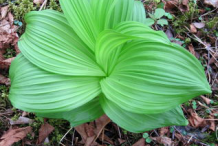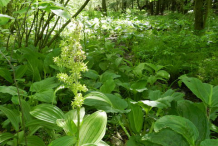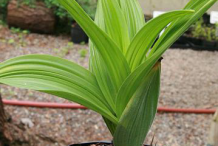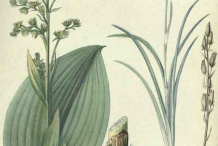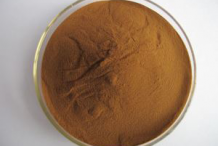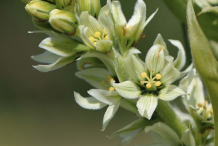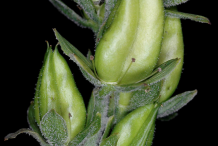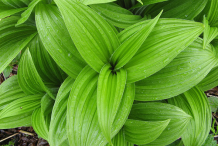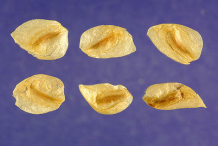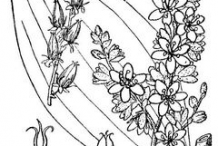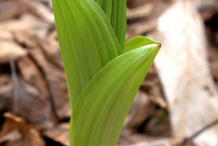Plant Description
False Hellebore is an herbaceous perennial plant that grows about 0.7–2 m tall. The plant is found growing in moist to wet meadows, thickets, swamps, stream-banks, and open forests from the lowland and all the way to the alpine zones. It prefers deep fertile moisture retentive humus-rich soil and normally dislikes dry soils, preferring to grow in a bog garden. The plant has solid green stem. Leaves are spirally arranged, 10–35 cm long and 5–20 cm broad, elliptic to broad lanceolate ending in a short point, heavily ribbed and hairy on the underside. The leaves are usually oval to linear.
Flower & Fruits
Flowers are numerous, produced in a large branched inflorescence 30–70 cm tall; each flower is star shaped 5–12 mm long, with six green to yellow-green tepals. The flowers are short pedicled and often unisexual. Flowering usually occurs from Jul to August. Fruit is a capsule 1.5–3 cm long, which splits into three sections at maturity to release the numerous flat 8–10 mm (0.3 to 0.4 in) diameter seeds.
Varieties
There are two major varieties of false hellebore:
Veratrum viride var. viride:
Veratrum viride var. viride grows in eastern North America from southern Quebec as far south as northern Georgia. It is differentiated by the erect or spreading side branches of the inflorescence.
Veratrum viride var. eschscholzianum:
Veratrum viride var. eschscholzianum grows in western North America from Alaska and Northwest Territory south along the Coast Range to the Pacific Northwest and northern California. They are wildly growing herbaceous perennials. It is differentiated by the drooping side branches of the inflorescence.
Traditional Uses and benefits of False Hellebore
- American Hellebore was used internally to treat pneumonia, peritonitis, epilepsy, pain, asthma, colds, cholera, croup, consumption, dyspepsia, fever, hypertension, herpes, gout, headache, inflammation, neuralgia, whooping cough, puerperal fever, scarlet fever, sciatica, rheumatism, shingles, toothache, scrofulous, tumors and typhus.
- It was used externally for throat infections and tonsillitis (as a gargle solution), neuralgia, and skin irritations.
- It has been used in the past against high blood pressure and rapid heartbeat.
- Standardized extract of V. viride alkaloids known as alkavervir was used in the 1950s and 1960s as an antihypertensive.
- Several native North American Indian tribes used it mainly externally in the treatment of wounds, pain etc.
- Some of these alkaloids lower blood pressure and dilate the peripheral vessels – they have, for example, been used in conventional medicine to treat high blood pressure and rapid heartbeat.
- Root is analgesic, diaphoretic, emetic, expectorant, febrifuge, narcotic and sedative.
- Root has been used in the treatment of acute cases of pneumonia, peritonitis and threatened apoplexy.
- Decoction of the root has been used in the treatment of chronic coughs and constipation.
- Portion of the root has been chewed, or a decoction used, in the treatment of stomach pain.
- Root has been used to make a skin wash and compresses for bruises, sprains and fractures.
- Powdered root has been applied as a healing agent to wounds and as a delousing agent.
- Stems have been scraped and the powder snuffed to induce sneezing.
- An infusion of the leaves has been used as a wash to treat aches and pains.
- Plant is used in homeopathic preparations to slow the heart rate.
- It encourages fall of Systolic and Diastolic blood pressure.
- It also treats Bradycardia.
- It is best used to treat congestion of lungs, acute rheumatic fever with scanty red urine, Sick headache with violet Nausea and vomiting, basilar meningitis, cerebrospinal diseases and twitching.
Dosage
Mode of Administration: The herb can be found in whole and powdered forms.
Daily Dose: The daily dose is 100 mg.
Storage: The drug should be clearly labeled as “poisonous” and stored in a safe place.
Other Facts
- Root contains even higher concentrations than the aerial parts.
- Plant was used by some tribes to elect a new leader. All the candidates would eat the root, and the last to start vomiting would become the new leader.
- After the plant dies down in the autumn and has been frosted, the toxins decrease and the plant becomes harmless to animals.
- Dried and powdered root is used as an insecticide and a parasiticide.
- It is also effective against caterpillars and mammals so great caution is advised.
- Roots have been grated then added to the laundry water and used to clean clothing.
- Plants from this genus are powdered to help create the garden insecticide, “Hellebore”.
- Gitxsan people dried and sliced the rhizome, then burnt it to drive away evil spirits.
- Hunters have added it to their laundry to remove the smell of human.
- The Wet’suwet’en believed you would become lucky if you bathed in liquid from the roots of Indian hellebore.
- Fiber obtained from the stem is used for weaving wallets etc.
Precautions
- Plant is highly toxic, causing nausea and vomiting.
- If the poison is not evacuated, cold sweat and vertigo appears, respiration slows cardiac rhythm and blood pressure falls, eventually leading to death.
- All parts of the plant are highly poisonous.
- Any use of this plant should be carried out with great caution and preferably only under the supervision of a qualified practitioner.
- Even when applied externally to unbroken skin it has been known to cause side-effects.
- High doses may cause vomiting and Diarrhea.
- Avoid during Pregnancy and breastfeeding.
- It contains several steroidal alkaloids that may cause severe slowing of heart rate and breathing, paralysis, and a number of other painful and debilitating symptoms.
- Herb reduces blood pressure and slows down the pulse due to the alkaloid germitrin.
- First symptoms of poisoning are sneezing, lacrimation, salivation, vomiting, diarrhea, burning sensation in the mouth and pharyngeal space, and inability to swallow; then, following resorption: paresthesia, vertigo, possible blindness, paralysis of the limbs; also mild convulsions, lowering of cardiac frequency, cardiac arrhythmias and hypotension.
- Death occurs either through systolic cardiac arrest or through asphyxiation.
- Alkaloids can also be absorbed through uninjured skin.
References:
https://www.itis.gov/servlet/SingleRpt/SingleRpt?search_topic=TSN&search_value=42764#null
https://davesgarden.com/guides/pf/go/53080/
https://plants.usda.gov/core/profile?symbol=vevi
https://botanical.com/botanical/mgmh/h/helgre16.html
http://www.pfaf.org/User/Plant.aspx?LatinName=Veratrum+viride
https://en.wikipedia.org/wiki/Veratrum_viride
Comments
| False Hellebore (American Hellebore) Quick Facts | |
|---|---|
| Name: | False Hellebore (American Hellebore) |
| Scientific Name: | Veratrum viride |
| Origin | Eastern and western North America |
| Shapes | Capsule 1.5–3 cm long, which splits into three sections at maturity |
| Taste | Acrid |
| Name | False Hellebore |
|---|---|
| Scientific Name | Veratrum viride |
| Native | Eastern and western North America |
| Common Names | Indian Poke, Indian Hellebore, False Hellebore, Green False Hellebore, giant false-helleborine, American False Hellebore, American White Hellebore, Bear Corn, Big Hellebore, Corn Lily, Devils Bite, Duck Retten, Itch-weed, Itchweed, Poor Annie, swamp hellebore |
| Name in Other Languages | English: American false hellebore, American white-hellebore, American-hellebore, Indian poke, Giant false helleborine, Green false hellebore, Green veratrum, Itchweed, American wild, green hellebore, hellebore, Indian hellebore, Indian Poke French: Vérâtre blanc, Varaire, Vérâtre verti, Vérâtre vert, Hellébore, Hellébore blanc, Tabac du diable, Varaire vert German: Grüner Germer Swedish: Grön nysrot |
| Plant Growth Habit | Herbaceous perennial plant |
| Growing Climate | Found growing in moist to wet meadows, thickets, swamps, stream-banks, and open forests from the lowland and all the way to the alpine zones |
| Soil | Deep fertile moisture retentive humus-rich soil. |
| Plant Size | 0.7–2 m tall |
| Stem | Solid green stem |
| Leaf | Spirally arranged, 10–35 cm long and 5–20 cm broad, elliptic to broad lanceolate ending in a short point |
| Flowering Periods | Jul to August |
| Flower | Numerous, produced in a large branched inflorescence 30–70 cm tall; each flower is star shaped 5–12 mm long, with six green to yellow-green tepals. |
| Fruit | Capsule 1.5–3 cm long, which splits into three sections at maturity to release the numerous flat 8–10 mm (0.3 to 0.4 in) diameter seeds. |
| Taste | Acrid |
| Seed | Numerous flattened, light brown and winged 8–10 mm diameter seeds |
| Plant Parts Used | Dried rhizome and roots, bulbs |
| Varieties |
|
| Culinary Uses |
|


